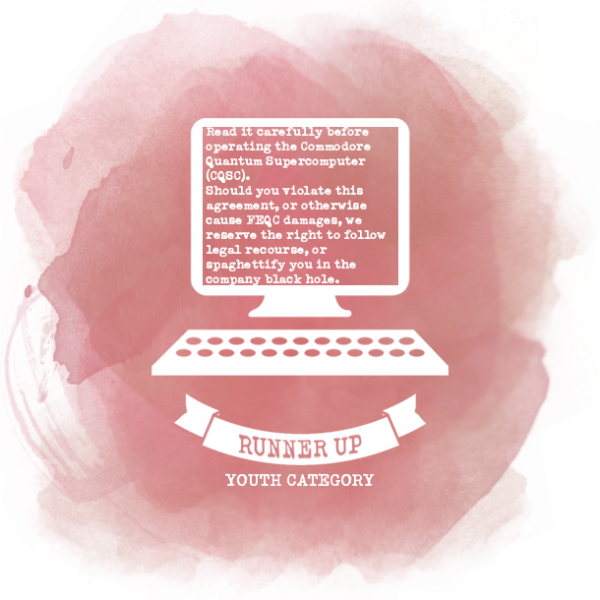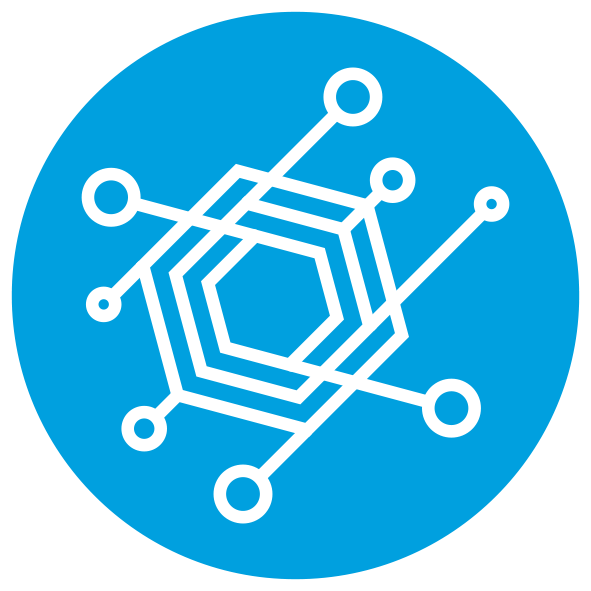Submitted by Morgan Long
on December 01, 2017

QUANTUM SHORTS 2017: RUNNER UP, YOUTH CATEGORY
>> Read an interview with the author
Terry was running late when he got to the lab. As he was walking in, he checked his phone. Upon checking his email, he noticed one from FE-QuiCk.
Computer Delivered
Fermi Enterprises – Quantum Computing Inc.\
Your Commodore Quantum Supercomputer has been delivered. Before using it, make sure to read and agree to our Terms of Service.
Thank You
This was an automated message
Do not respo…
Terry, having nothing better to do until his elevator arrived, decided to check out the Terms of Service.
End-User License Agreement
Last updated: November 29, 2043
This End-User License Agreement (EULA) is a legal contract between the user, and Fermi Enterprises – Quantum Computing Inc. (FEQC). Read it carefully before operating the Commodore Quantum Supercomputer (CQSC). Should you violate this agreement, or otherwise cause FEQC damages, we reserve the right to follow legal recourse, or spaghettify you in the company black hole. By using, the CQSC, you are agreeing to the following –
1 General License
1.1 Subject to your ongoing compliance to the EULA, FEQC grants general use of a CQSC. Remember, the CQSC is licensed, not sold.
1.2 The licence is non-local, and your computer may disable itself faster than the speed of light should you fail to comply with the rest of the EULA.
2 General License Conditions
2.1 You may not provide, make available, or otherwise grant another user access to the CQSC.
2.2 You may not modify, disassemble, or otherwise tamper with the CQSC, except when specifically instructed to do so by FEQC.
2.3 You must follow all directions given by an FEQC representative if a catastrophic event involving the CQSC occurs, or will occur. Such an event could occur if the deuterium fusion reactor melts down, the Cesium clock explodes, or the Delta-Kappa wormhole collapses.
2.4 The CQSC should be kept safe and separate from the all of the following – water, humidity, electrical surges, perchloric acid, neutrinos, proton beams, positron beams, and any high damage beam. The CQSC should also be kept away from any anti-CQSC’s, and you should avoid contact with anti-you’s. To prevent this, when not in use the CQSC should be constantly observed, to prevent virtual particles from damaging the CQSC.
2.5 The CQSC is to be used solely by you, and not to be reverse engineered, and spread. Any attempt to do so will erase the CQSC’s computing capacity, due to the no cloning theorem. Should a copy be successfully violating this theorem, you are required to contact us about the event. Any prize, Nobel or otherwise, based on this discovery is under the sole ownership of FEQC. Further, the CQSC will disable at previously mentioned speeds.
3 Required Operational Instructions
3.1 Prior to operation, make sure you have read the operator’s manual, available at…
Ding. Terry lowered his phone, and stepped into the elevator. He punched the number for his lab, which was deep in the earth. And unfortunately, there were plenty of stops to make before he got there. As the doors slid shut, Terry felt dread at the thought of continuing to read the EULA, and decided to read the manual.
This is the manual for the Model Q-2310, Q-4300, and the Q-9009.
1 Read all instructions.
2 Do not push the large red button labeled “Push Me” under any circumstances.
Terry skimmed ahead.
19 Always keep power cord straight, never let it bend, unless you have a Q-9009, which should have a coil of wire, which should never be straight.
20 When unplugging the computer, always pull from the head of the power cord. Failure to do so may lead your electrocution, damage the cord, or turn you into a being of pure energy.
21 Do not use outdoors
22 Do not use in a non-climate controlled room. The room should be kept at a constant of “uncomfortably warm,” with no humidity.
23 Always wear a lead lined hazmat suit when within 10 feet of the computer, especially if it is off.
Usage
First, plug in the machine. To run a program, insert your punch cards into the slot labeled “Punch Cards In.” Once the program has been run, it should output new punch cards out the slot labeled “Punch Cards Out.” While the computer is running make sure you do not observe the computer, as you may collapse the computer’s superpositions, voiding the warranty…
Terry skimmed further ahead, already familiar with working around the uncertainty principle.
Troubleshooting
If it does not output any cards, this is because the computer is out of punch cards, or has been caught in an infinite loop. To prevent this, the computer will produce an error message once it has reached the maximum number of computations. This maximum number is configurable, see page 72. By default, the computer will error after 4.9999976 computations….
Ding. Terry stepped out, and walked to his lab. Sitting in the middle of the lab were several massive boxes, with “Fermi Enterprises – Quantum Computing Inc.” stamped on them. Below this stamp was another one saying “Commodore Quantum Supercomputer, some assembly required.” Terry called his assistants to help him set it up. They suited up, and began assembling. 7 hours and a missed lunch break later, Terry set aside the unnecessary pieces, and pushed the start button. As the computer hummed to life, the machine spit out a punch card. After using the manual to translate the card from FORTRAN, he read “Do you agree to the terms and conditions of this product?”
Terry pulled out his phone, and navigated to the EULA. He opened it, and scrolled to the bottom.
91.6 Beware of Evil Squirrels
91.7 All work done on the Computer, and the producer, is owned by FEQC. This includes you, should you use the CQSC.
Do you agree to the terms and conditions outlined in this document?
Yes[ ]
No [ ]
“There are only two possibilities: yes or no,” thought Terry.
Terry checked the Yes box.
About the Author:
I am a 17 year old senior in high school in Katy, TX. When not reading about physics, I am camping with Boy Scouts or playing games with friends and family. I am hoping to study particle physics in college.



